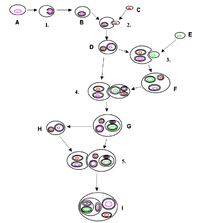
Photo from wikipedia
Potato virus Y (PVY) is a destructive plant virus causing important damage in different crops, particularly in potato. PVY is transmitted in a non-persistent manner by many aphid species, and… Click to show full abstract
Potato virus Y (PVY) is a destructive plant virus causing important damage in different crops, particularly in potato. PVY is transmitted in a non-persistent manner by many aphid species, and the distal part of the stylet plays an important role in virus transmission by these aphids. Among other possible factors, the type of host plant on which the aphids develop could also affect virus transmission efficiency, yet little is known about this. Furthermore, the quantification of potyviruses in individual vectors has mainly focused on intact whole aphid body and not the stylet alone, whereas an even more precise indicator that could correlate with vector efficiency in non-persistently transmitted viruses is the quantity of the virus in the stylet. Therefore, this study aims to verify the effect of different host plants on which an aphid vector was reared on its ability to acquire and transmit the PVY, and whether the quantity of PVY in the aphid vector stylet could be used as a useful trait for evaluating vector efficiency. A key finding in this study indicates that when the aphid Myzus persicae was reared on broad bean and then exposed to acquire PVY, it transmitted PVY less efficiently (50%) compared to when it was reared on Brussels sprout (81%). Additionally, the transmission percentage correlated directly with the virus quantity in the stylet (r = 0.7) and not in the intact whole aphid body (r = 0.06). This could be exploited as a useful index for virus transmission efficiency in epidemiological studies or predictive schemes.
Journal Title: Journal of Plant Diseases and Protection
Year Published: 2019
Link to full text (if available)
Share on Social Media: Sign Up to like & get
recommendations!